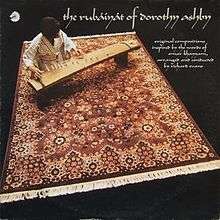The Rubaiyat of Dorothy Ashby
| The Rubaiyat of Dorothy Ashby | ||||
|---|---|---|---|---|
 | ||||
| Studio album by Dorothy Ashby | ||||
| Released | 1970, 2007 (reissue) | |||
| Recorded |
November 1969 – January 1970 Ter Mar Studios, Chicago | |||
| Genre | Jazz | |||
| Length | 39:17 | |||
| Label |
Cadet DGA 3002 | |||
| Producer | Richard Evans | |||
| Dorothy Ashby chronology | ||||
| ||||
The Rubaiyat of Dorothy Ashby (subtitled Original compositions inspired by the words of Omar Khayyam, arranged and conducted by Richard Evans) is an album by jazz harpist Dorothy Ashby recorded in late 1969 and early 1970 and released on the Cadet label.[2] On this album, Ashby plays the Japanese musical instrument, the koto, demonstrating her abilities to successfully integrate another instrument into jazz.[3]
Reception
| Professional ratings | |
|---|---|
| Review scores | |
| Source | Rating |
| AllMusic | |
| Record Collector | |
Reviewing the album for AllMusic, Thom Jurek writes: "this is a head record. Time and space are suspended and new dimensions open up for anyone willing to take this killer little set on and let it spill its magic into the mind canal through the ears. Depending on how much of a jazz purist you are will give you a side to debate the place of this set in Ashby's catalogue. For those who remain open, this may be her greatest moment on record …"[4]
Track listing
All compositions by Dorothy Ashby.
- "Myself When Young" - 5:16
- "For Some We Loved" - 4:02
- "Wax and Wine" - 4:25
- "Drink" - 2:30
- "Wine" - 3:56
- "Dust" - 2:51
- "Joyful Grass and Grape" - 3:38
- "Shadow Shapes" - 3:32
- "Heaven and Hell" - 3:10
- "The Moving Finger" - 5:39
Personnel
- Dorothy Ashby - harp, koto, vocals
- Lenny Druss - flute, oboe, piccolo flute (tracks 1-5 & 10)
- Cliff Davis - alto saxophone (track 10)
- Stu Katz - vibraphone (tracks 1, 3, 4, 6 & 8-10)
- Cash McCall - guitar (track 10)
- Fred Katz - kalimba (tracks 2, 3 & 10)
- Ed Green - violin (track 2)
- Unidentified orchestra arranged and conducted by Richard Evans
References
- ↑ "Dorothy Ashby – The Rubaiyat Of Dorothy Ashby". Retrieved July 1, 2014.
- ↑ Cadet Album Discography (1965–1971) accessed May 13, 2013
- ↑ "Dorothy Ashby". blax-jive.com. December 7, 2011. Retrieved 14 April 2016.
- 1 2 Jurek, Thom AllMusic review accessed May 13, 2013.
- ↑ "Dorothy Ashby – Rubaiyat Of CD Album" > "Product Review(s)". CD Universe/Muze. Retrieved September 29, 2015.